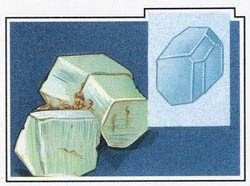Salt grains are shaped like tiny cubes.
Regular shapes like this are called crystals.
Many elements and compounds form crystals. The crystals in salt are easy to see. But other crystals are so small that you need to look through a microscope to see them.
Sugar and ice form crystals.
The atoms in different crystals join together to form different patterns.
There are seven basic patterns of crystal.
The atoms of garnet form isometric crystals.
The atoms of quartz form rhombohedral crystals.
The atoms of zircon form tetragonal crystals.
The atoms of beryl form hexagonal crystals.
The atoms of topaz form orthorhombic crystals.
The atoms of gypsum form monoclinic crystals.
The atoms of feldspar form triclinic crystals.
Many rocks and metals in the earth's surface are found as crystals, too. The crystals of each element or compound are the same. Crystals are made when liquids cool or solutions dry out. Some of the atoms move closer together.
The crystals form in regular shapes because the atoms in the crystals arrange themselves in patterns. Crystals can grow larger over time as they attract more particles towards them. But each different crystal will always keep the same shape.
Atoms can be arranged in a variety of repeating patterns to make different crystals


















Social Plugin